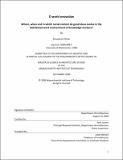D-work innovation : where, when and in which social context do good ideas evolve in the distributed work environment of knowledge workers?
Author(s)
Dimas, Anastasios
DownloadFull printable version (5.590Mb)
Alternative title
Where, when and in which social context do good ideas evolve in the distributed work environment of knowledge workers?
Other Contributors
Massachusetts Institute of Technology. Dept. of Architecture.
Advisor
Kent Larson.
Terms of use
Metadata
Show full item recordAbstract
The nature of work is changing. Until recently, the majority of people worked in fixed, team-based collaborations in collocated settings for fixed periods of time. Currently we are experiencing a major shift towards distributed work. D-work is multi-tasking (workers participate in many projects and teams that often change), multi-locational (work is conducted by people located in different divisions, firms, organizations and time-zones) and mobile (people conduct work while transiting). D-Work changes the definition of the traditional office and blurs the boundaries between home, workplace and the city. Homes will have to accommodate work, businesses must adapt their policies and office spaces to D-work and cities have to adapt to new patterns of mixed work-live units. At the moment, workers, managers and designers have become less aware of where, when, with whom and during which activities, does the most productive and creative work take place. In an effort to tackle the above mentioned issue, we developed a methodology that combines Context-Aware Experience Sampling with traditional ethnographic tools. Our system is composed of a Bluetooth-based positioning system, a context-aware self-report survey administered on mobile phones and traditional questionnaires. The methodology was tested via a four week case study on innovation that was conducted in a marketing firm based in Helsinki. During the study we collected data from eleven participants about the occurrence of work-related ideas and barriers inside and outside the office space. (cont.) All participants provided us with information about their work habits by filling out a questionnaire prior to the beginning of the study. By juxtaposing their answers to their actual work-life data that we collected, similarities and discrepancies between the two emerged that helped us to understand and assess their work behavior. General results as well as personal reports that were compiled for three subjects are presented and analyzed. An overall assessment of the system and suggested improvements based on results and participant feedback are also discussed.
Description
Thesis (S.M.)--Massachusetts Institute of Technology, Dept. of Architecture, 2009. This electronic version was submitted by the student author. The certified thesis is available in the Institute Archives and Special Collections. Cataloged from student-submitted PDF version of thesis. Includes bibliographical references (p. 158-160).
Date issued
2009Department
Massachusetts Institute of Technology. Department of ArchitecturePublisher
Massachusetts Institute of Technology
Keywords
Architecture.